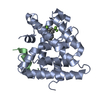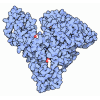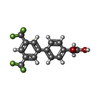Entry Database : PDB / ID : 6sjmTitle Crystal structure of the Retinoic Acid Receptor alpha in complex with compound 24 (JP175) Nuclear receptor coactivator 2 Retinoic acid receptor RXR-alpha Keywords / / / / / / Function / homology Function Domain/homology Component
/ / / / / / / / / / / / / / / / / / / / / / / / / / / / / / / / / / / / / / / / / / / / / / / / / / / / / / / / / / / / / / / / / / / / / / / / / / / / / / / / / / / / / / / / / / / / / / / / / / / / / / / / / / / / / / / / / / / / / / / / / / / / / / / / / / / / / / / / / / / / / / / / / / / / / / / / / / / / / / / / / Biological species Homo sapiens (human)Method / / / Resolution : 2.52 Å Authors Chaikuad, A. / Pollinger, J. / Arrowsmith, C.H. / Edwards, A.M. / Bountra, C. / Merk, D. / Knapp, S. / Structural Genomics Consortium (SGC) Journal : Acs Med.Chem.Lett. / Year : 2019Title : A Novel Biphenyl-based Chemotype of Retinoid X Receptor Ligands Enables Subtype and Heterodimer Preferences.Authors : Pollinger, J. / Schierle, S. / Gellrich, L. / Ohrndorf, J. / Kaiser, A. / Heitel, P. / Chaikuad, A. / Knapp, S. / Merk, D. History Deposition Aug 13, 2019 Deposition site / Processing site Revision 1.0 Sep 18, 2019 Provider / Type Revision 1.1 Oct 2, 2019 Group / Database references / Category / citation_authorItem _citation.country / _citation.journal_abbrev ... _citation.country / _citation.journal_abbrev / _citation.journal_id_CSD / _citation.journal_id_ISSN / _citation.journal_volume / _citation.page_first / _citation.page_last / _citation.pdbx_database_id_DOI / _citation.pdbx_database_id_PubMed / _citation.title / _citation.year Revision 1.2 Aug 10, 2022 Group / Derived calculationsCategory database_2 / pdbx_struct_assembly ... database_2 / pdbx_struct_assembly / pdbx_struct_assembly_gen / pdbx_struct_assembly_prop / pdbx_struct_oper_list Item _database_2.pdbx_DOI / _database_2.pdbx_database_accession ... _database_2.pdbx_DOI / _database_2.pdbx_database_accession / _pdbx_struct_assembly.details / _pdbx_struct_assembly.method_details / _pdbx_struct_assembly.oligomeric_count / _pdbx_struct_assembly.oligomeric_details Revision 1.3 Jan 24, 2024 Group / Refinement descriptionCategory / chem_comp_bond / pdbx_initial_refinement_model
Show all Show less
 Yorodumi
Yorodumi Open data
Open data Basic information
Basic information Components
Components Keywords
Keywords Function and homology information
Function and homology information Homo sapiens (human)
Homo sapiens (human) X-RAY DIFFRACTION /
X-RAY DIFFRACTION /  SYNCHROTRON /
SYNCHROTRON /  MOLECULAR REPLACEMENT / Resolution: 2.52 Å
MOLECULAR REPLACEMENT / Resolution: 2.52 Å  Authors
Authors Citation
Citation Journal: Acs Med.Chem.Lett. / Year: 2019
Journal: Acs Med.Chem.Lett. / Year: 2019 Structure visualization
Structure visualization Molmil
Molmil Jmol/JSmol
Jmol/JSmol Downloads & links
Downloads & links Download
Download 6sjm.cif.gz
6sjm.cif.gz PDBx/mmCIF format
PDBx/mmCIF format pdb6sjm.ent.gz
pdb6sjm.ent.gz PDB format
PDB format 6sjm.json.gz
6sjm.json.gz PDBx/mmJSON format
PDBx/mmJSON format Other downloads
Other downloads 6sjm_validation.pdf.gz
6sjm_validation.pdf.gz wwPDB validaton report
wwPDB validaton report 6sjm_full_validation.pdf.gz
6sjm_full_validation.pdf.gz 6sjm_validation.xml.gz
6sjm_validation.xml.gz 6sjm_validation.cif.gz
6sjm_validation.cif.gz https://data.pdbj.org/pub/pdb/validation_reports/sj/6sjm
https://data.pdbj.org/pub/pdb/validation_reports/sj/6sjm ftp://data.pdbj.org/pub/pdb/validation_reports/sj/6sjm
ftp://data.pdbj.org/pub/pdb/validation_reports/sj/6sjm
 F&H Search
F&H Search Links
Links Assembly
Assembly

 Components
Components Homo sapiens (human) / Gene: RXRA, NR2B1 / Plasmid: pNIC28-Bsa4 / Production host:
Homo sapiens (human) / Gene: RXRA, NR2B1 / Plasmid: pNIC28-Bsa4 / Production host: 
 Homo sapiens (human) / References: UniProt: Q15596
Homo sapiens (human) / References: UniProt: Q15596 X-RAY DIFFRACTION / Number of used crystals: 1
X-RAY DIFFRACTION / Number of used crystals: 1  Sample preparation
Sample preparation SYNCHROTRON / Site:
SYNCHROTRON / Site:  SLS
SLS  / Beamline: X06SA / Wavelength: 1 Å
/ Beamline: X06SA / Wavelength: 1 Å Processing
Processing MOLECULAR REPLACEMENT
MOLECULAR REPLACEMENT Movie
Movie Controller
Controller


 PDBj
PDBj













